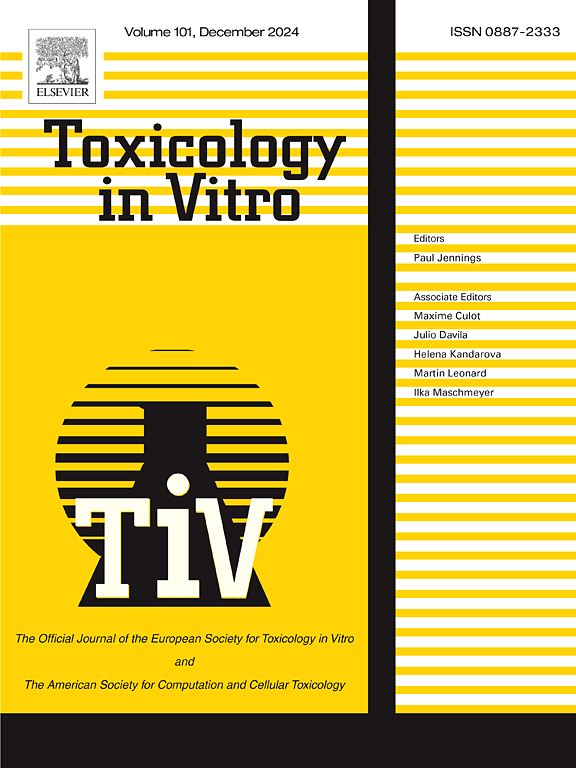Anticancer activity of EMD37 against human head and neck cancer: Impact on apoptotic and inflammatory machineries
IF 2.7
3区 医学
Q3 TOXICOLOGY
引用次数: 0
Abstract
Accumulating evidence emphasizes the tumorigenic role of epidermal growth factor receptor (EGFR) in head and neck cancer (HNC). Although cetuximab is the sole anti-EGFR approved by the Food and Drug Administration for treating HNC patients.its response rates are modest. Thus, novel effective and tolerable therapeutic strategies are urged. We previously reported the capability of oxadiazole derivatives to degrade tyrosine kinase receptors including EGFR and exhibit potent anticancer activities against NCI-60 panel which does not include HNC. The aim of this study was to investigate the potential anticancer activity of EMD37, a novel 1,2,4-oxadiazole derivative, against human HNC cells and if effective, to examine the effect of EMD37 on apoptotic and inflammation mediators. Indeed, EMD37 exhibited potent cytotoxicity against patient-derived HNC cell lines (HNO-97, HN-9 and FaDu). Delving deeper, EMD37 triggered intrinsic and extrinsic apoptosis in HNC cells as evidenced by increased levels of caspase-8, caspase-9, caspase-3, caspase-7, caspase-6, TP53BP1 tumor suppressor and Bax, and downregulated anti-apoptotic Bcl-2 protein. EMD37 also significantly abrogated the levels of pro-inflammatory interleukin-1β, interleukin-6, cyclooxygenase-2 and matrix metalloproteinases (MMP-2 and MMP-9) which are heightened in HNC. Bioinformatic analysis revealed that BCL2low, IL6low and MMP9low HNC biospecimens are enriched with epithelial cell differentiation gene set, and CASP8high cohort is enriched with extrinsic apoptosis. Altogether, this study emphasizes the therapeutic potential of targeting the apoptotic and inflammatory machineries in HNC using EMD37.
EMD37 对人类头颈癌的抗癌活性:对凋亡和炎症机制的影响
越来越多的证据强调了表皮生长因子受体(EGFR)在头颈癌(HNC)中的致瘤作用。尽管西妥昔单抗是美国食品药品管理局批准用于治疗 HNC 患者的唯一抗表皮生长因子受体药物,但其反应率并不高。因此,迫切需要新型有效且可耐受的治疗策略。我们曾报道过噁二唑衍生物能降解包括表皮生长因子受体在内的酪氨酸激酶受体,并对 NCI-60 小组(不包括 HNC)表现出强大的抗癌活性。本研究的目的是调查 EMD37(一种新型 1,2,4-恶二唑衍生物)对人类 HNC 细胞的潜在抗癌活性,如果有效,则研究 EMD37 对细胞凋亡和炎症介质的影响。事实上,EMD37对来源于患者的HNC细胞系(HNO-97、HN-9和FaDu)具有强大的细胞毒性。深入研究发现,EMD37可触发HNC细胞的内源性和外源性凋亡,表现为caspase-8、caspase-9、caspase-3、caspase-7、caspase-6、TP53BP1肿瘤抑制因子和Bax水平的升高,以及抗凋亡Bcl-2蛋白的下调。EMD37还能明显降低白细胞介素-1β、白细胞介素-6、环氧化酶-2和基质金属蛋白酶(MMP-2和MMP-9)的水平,而这些物质在HNC中的水平会升高。生物信息学分析表明,BCL2低、IL6低和MMP9低的HNC生物样本富集了上皮细胞分化基因集,而CASP8高的队列富集了外源性凋亡基因集。总之,这项研究强调了利用EMD37靶向HNC凋亡和炎症机制的治疗潜力。
本文章由计算机程序翻译,如有差异,请以英文原文为准。
求助全文
约1分钟内获得全文
求助全文
来源期刊

Toxicology in Vitro
医学-毒理学
CiteScore
6.50
自引率
3.10%
发文量
181
审稿时长
65 days
期刊介绍:
Toxicology in Vitro publishes original research papers and reviews on the application and use of in vitro systems for assessing or predicting the toxic effects of chemicals and elucidating their mechanisms of action. These in vitro techniques include utilizing cell or tissue cultures, isolated cells, tissue slices, subcellular fractions, transgenic cell cultures, and cells from transgenic organisms, as well as in silico modelling. The Journal will focus on investigations that involve the development and validation of new in vitro methods, e.g. for prediction of toxic effects based on traditional and in silico modelling; on the use of methods in high-throughput toxicology and pharmacology; elucidation of mechanisms of toxic action; the application of genomics, transcriptomics and proteomics in toxicology, as well as on comparative studies that characterise the relationship between in vitro and in vivo findings. The Journal strongly encourages the submission of manuscripts that focus on the development of in vitro methods, their practical applications and regulatory use (e.g. in the areas of food components cosmetics, pharmaceuticals, pesticides, and industrial chemicals). Toxicology in Vitro discourages papers that record reporting on toxicological effects from materials, such as plant extracts or herbal medicines, that have not been chemically characterized.
 求助内容:
求助内容: 应助结果提醒方式:
应助结果提醒方式:


